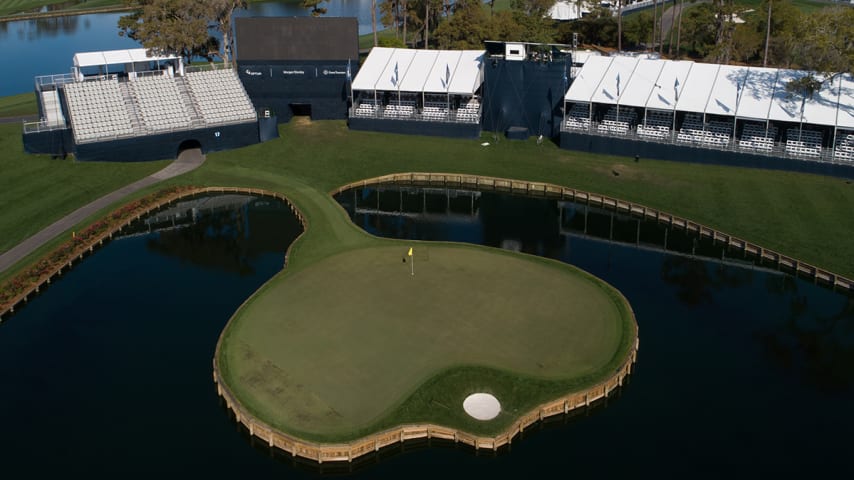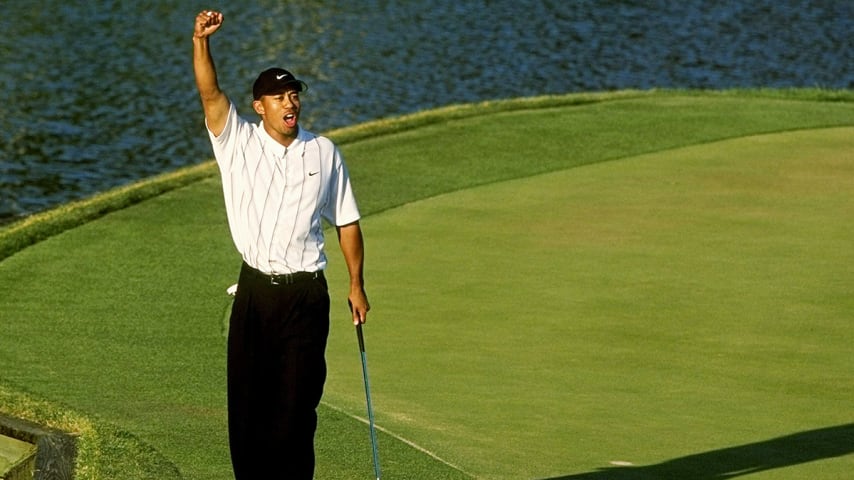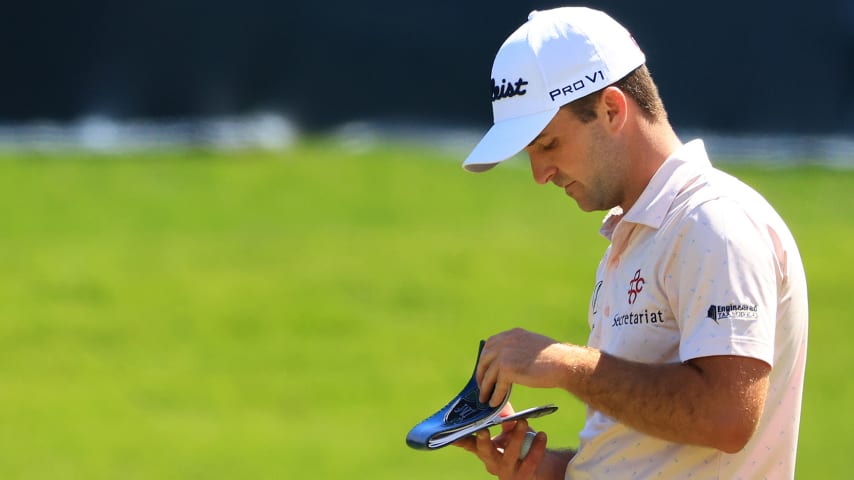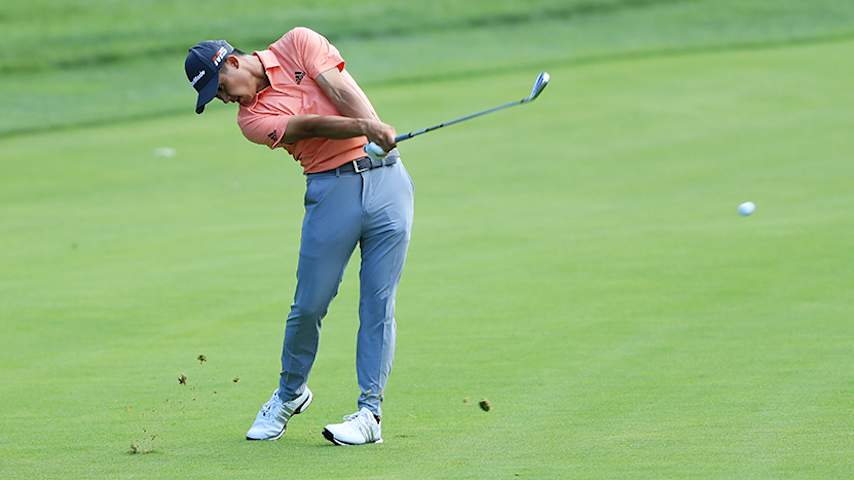THE PLAYERS Championship’s greatest comeback
18 Min Read

PONTE VEDRA BEACH, FL - MARCH 13: (EDITOR'S NOTE: Image taken with a drone.) View of the 17th green during the second round of the canceled PLAYERS Championship on THE PLAYERS Stadium Course at TPC Sawgrass on March 13, 2020, in Ponte Vedra Beach, FL. (Photo by Ben Jared/PGA TOUR via Getty Images)
How the tournament, and the TOUR, returned after getting caught in the COVID-19 crosshairs
Written by Cameron Morfit
How the tournament, and the TOUR, returned after getting caught in the COVID-19 crosshairs
It is a measure of how odd THE PLAYERS Championship was last year that while no one can forget it, almost no one remembers any golf. For the record, Hideki Matsuyama shot 63 to lead after an opening round that, like the tournament itself, was never completed.
Tense, real-time decision-making; Rubik’s Cube-level communication and coordination between local, state and federal agencies; a 144-way tie for first – whatever else it was, the 2020 PLAYERS was sui generis. It was also a whole lot of tacos and margaritas that went unsold.
“It was second time in March for us,” says Don Nicol, owner of Taco Lu restaurant, which sets up behind the 12th green for Tacos on Twelve. “The year before had been a little disappointing, the weekend weather was chilly after being beautiful Tuesday through Friday. It was a dip in business.
“Last year we had three record days in a row, Tuesday, Wednesday and Thursday,” Nicol continues. “It was beautiful. Last year might have been the best weather in the history of the tournament.”
Well, so much for that.
The world comes to TPC Sawgrass
Although the first report of a coronavirus death in the U.S. was Feb. 29, some two weeks earlier, the early take during PLAYERS week was that the virus would stay away. The people wearing masks were mostly overseas, and previous epidemics like SARS, MERS, H1N1 and Ebola were mostly non-fatal or not spread through airborne particles by asymptomatic carriers.
All of which had left many Americans, not just golf fans, with a false sense of security as the world poured into Jacksonville for THE PLAYERS. On Monday, as PGA TOUR Commissioner Jay Monahan sat in the offices of CNBC in New York to discuss the TOUR’s new television deals, he sensed the virus would be impacting business but felt there was still time.
He was one of many.
“I was in LA shooting something Olympics-related, ironically,” says Mike Tirico, who would host NBC’s coverage from TPC Sawgrass. “I flew LA to Atlanta to Jacksonville, and you got the sense that things were changing. We were pre-mask. I got there Tuesday night.”
That night his announce partner Dan Hicks hosted the annual Military Appreciation concert.
“I remember looking out at this huge crowd in the amphitheater around 17,” Hicks says, “and I’ve got to be honest, I didn’t think anything of it. I approached it as business as usual.”
So did much of the field.
“Since I was a first-timer, I’d done the rookies’ press conference,” says local TOUR pro Lanto Griffin. “And not one person had mentioned the virus and whether we might not be playing.”
Bad news out of the NBA
There was no escaping the grim reality of the situation by Wednesday night. Monahan and his wife Susan were hosting the annual Commissioner’s party, an event for which he assiduously avoids looking at his phone in order to focus on the guests. Many of those guests had just arrived but admitted they had changed their travel plans and would be leaving the next day.
After the last partygoer had departed, Monahan turned his phone back on and absorbed the latest grim report: Utah Jazz player Rudy Gobert tested positive for the virus, which was followed in short order by the NBA suspending its season at 9:31 p.m.
“That’s when I knew that we had a bigger and more immediate problem as it related to the next four days of THE PLAYERS Championship,” Monahan told the Golf Channel for a one-year retrospective, involving several TOUR executives, that will air this week.
At 10 p.m., he convened “the latest executive team call I’ve ever been a part of,” said Laura Neal, Senior VP of Communications and Media Content.
The week had begun with such promise – Monahan in New York; Tiger Woods and Tim Finchem having been voted into the World Golf Hall of Fame; the debut of Every Shot Live (which will debut this week). Now, though, doubt and fear were spreading fast.
One of the options was to go without fans, which seemed extreme. Weren’t the fans everything?
“It moved so quickly,” Hicks says. “In a span of 24 hours, it all changed. Wednesday night, having dinner with my colleagues, some Golf Channel and NBC folks, we got news of the NBA being cancelled. I thought to myself there’s no way this championship is going to be completed.”
Prioritizing golf; compartmentalizing chaos
Although Thursday morning broke with more bad news – another Jazz player had tested positive – it was go-time for THE PLAYERS. Fans on site and at home were eager for a distraction, and the players performed admirably, pushing current events to the backs of their minds.
“It was my first week with my caddie back on the bag,” says Russell Knox, who lives just five minutes from the course. “We had worked together for four years in the past, and we were reuniting after a three-year break. And I five-putted for a triple on the first hole.”
Knox laughs at the memory. “We didn’t think about the coronavirus,” he says.
Others did.
“When we woke up Thursday morning, we saw how things were turning,” says Jon Rahm, who had a 1:51 p.m. tee time with Brooks Koepka and Rory McIlroy.
The TOUR announced at noon that there would be no on-site fans Friday, an unprecedented measure. Professional tennis, professional soccer, college basketball’s biggest conference tournaments, and the NHL cancelled or suspended their seasons.
“I remember eating with a couple other players,” Rahm says, “because we were teeing it up in about an hour and a half, and we were like, ‘What the hell are we doing? What’s going to happen?’ It’s going to be hard to forget that moment.”
‘That one day was pretty good’
Gardner Minshew, the Jacksonville Jaguars quarterback, was, like many, intent on having a good time Thursday. He had invited a friend, and his dad had driven from Mississippi, also with a friend. They made their way to the Jaguars’ box on 17 to watch the first round.
“There were whispers, are we going to be able to go,” Minshew says. “We were probably going to go all four days; we were pretty fired up for it. It was my first time ever going; everybody had talked about what a blast it is. I play golf on the weekends or whatever. Everybody drove in from Mississippi, my dad and his friend and one of my buddies, they all got in late the night before.
“About halfway through the day we found out that was going to be it,” Minshew continues. “So, we had to try and fit four days into one afternoon. We made it worth it, though; that one day was pretty good. We pretty much just informed the Jags that they were not stocked well enough; they didn’t anticipate our needs, especially in the Tito’s department, so we’re hoping that gets fixed.
“We didn’t want to see it end; we were having too good a time.”
They weren’t the only ones. Tacos on Twelve was slammed, as were other on-course vendors.
Meanwhile, the scores rolled in. Harris English, Christian Bezuidenhout and Si Woo Kim shot 65 to trail Matsuyama by two. Patrick Cantlay and Marc Leishman shot 67.
Ponte Vedra Beach resident Tommy Roy, who produces NBC’s golf coverage, was now tasked with covering the tournament while also covering an emerging global health emergency.
“Fortunately, we had Mike Tirico on the crew, our host, who is very connected with the sports world,” Roy says. “He was getting messages about all the different leagues and colleges getting ready to shut down, and one by one they all started doing so, and we were having to report that.”
Major League Baseball canceled spring training, the NCAA canceled all remaining winter and spring championships, including March Madness, and Disney World closed.
“It felt like this avalanche of bad news coming down in the middle of my favorite tournament,” Roy says. “But if you’re on air with live coverage and news is breaking you have to deal with it.”
Everyone had an opinion on whether THE PLAYERS should continue. Golf seemed like the perfect social-distancing sport, being played outside on hundreds of acres. Rory McIlroy was among the first to say that if all the players and caddies could be tested, then play on.
But was that even possible?
Crisis communications 101
TOUR execs huddled in a conference room in the clubhouse from 7 a.m. until almost 10 p.m. Thursday. Almost no other sports leagues remained standing, save for Ultimate Fighting, and the closure of Disney World seemed especially dire.
The official announcement of no on-site fans for the rest of the week came at 6:15 p.m. But was that enough? Neal had taken a crisis-communications class the previous summer, and the big takeaway was this: What would reasonable people expect a responsible organization to do in a crisis? With Monahan temporarily out of the room, she wrote it on the board.
Upon stepping back into the room, having immersed himself in talks with local, state and federal officials, Monahan eyed the board, and his team. Travel restrictions were going up seemingly everywhere. Almost no sport was left standing. The parks had closed. After taking precautions from extra sanitation to the agonizing call to keep fans away, there was nothing left to do.
The text went out at 10 p.m.
“We were going to bed, I had already turned my phone on Do Not Disturb,” says Rickie Fowler, who was staying at a friend’s house with Justin Thomas and their significant others. “JT is on my favorites list, I’m getting a Facetime call from him from 20 yards away. He goes, ‘Did you get the text? Did you get the news?’ I was like, ‘No, what?’
“He’s like, ‘Everything’s cancelled. It’s done,’” Fowler continues. “So I was like, ‘Hold on a second.’ Went downstairs, grabbed a couple drinks because all we’re gonna do the next day is drive home. We had two drinks and then, ‘All right, well, see ya later!’ Go back to bed.”
Most other players reported similar stories.
NBC’s Roy was sitting in his car at the Jacksonville Airport.
“We thought we were going to be broadcasting Friday without fans,” he says. “Well, how do you do that? If we weren’t going to get crowd noise, then I would play music more often. We were preparing for that, and we were fully prepared when we left the compound. I went to pick up my daughter, who was flying in from New York, and that’s when I got the word.
“I’m actually sitting in the cell phone lot waiting for her to land when I got the news that they were going to cancel,” he continues. “The primary thought is, OK, what are we going to do on the air tomorrow? And the safety of everybody. Everything was so unknown; it was a scary time. And on a personal level I was glad that my daughter was getting out of New York.”
Entering uncharted territory
McIlroy woke up early Friday, ready to roll. “Jumped in the shower and got dressed into all my golf stuff,” he says. “And was about to walk out the door and I looked at my phone. I was like, Oh, guess we're not playing today, so I probably found out a little later than most. Then it was just a matter of getting changed back into like casual clothes and going and picking my stuff up at the club and making the four-hour drive back home to Jupiter.”
He wasn’t the only one in the early-bedtime club. Scottie Scheffler also woke up ready to go.
There was an odd finality to everything in the cold light of day. THE PLAYERS was cancelled. The purse was split in half and divided equally amongst the players, roughly $52,000 apiece.
“It’s the most I’ve gotten paid to play that poorly the first day,” says Fowler, who shot 76. “I was planning to go play well the next day and make the cut.”
Concerns about hitting the green on 17 morphed into concerns about getting home, especially for global players. Bernd Wiesberger flew to Newark to catch the last flight back to Vienna, Austria. Rafa Cabrera Bello and his family, plus his agent and his family, holed up in their rental house on the beach, no one eager to return to hard-hit Spain or spend hours on an airplane.
It was Friday, the 13th. The sun shone and the fountains burbled as players and caddies rolled into Sawgrass and packed up their things. The TOUR had cancelled not only THE PLAYERS but also tournaments through the Valero Texas Open, April 2-5.
Monahan met with the media.
“I remember you could see it was exhausting and emotional for Jay to have to shut down the event and multiple tours for the foreseeable future,” Tirico says. “That was rough, no doubt.”
Flights were changed. Rides were bummed. Everyone tried to clean up any last loose ends.
“We did different on-camera taped bits for Friday, Saturday and Sunday,” Tirico says. “I wrote some stuff, we knocked that out, and then hit the road. It was the strangest golf tournament or sporting event that I was at – it got going and then 24 hours later it looked like Sunday night at a tournament. We all scattered. I left the host position at noon Friday and the place was empty.”
The NBC crew broke down, packed up and made plans to get home. Monahan was brought in for an interview with Tirico; not much else remained in the way of live coverage.
“I remember walking out of the Sawgrass Marriott,” Hicks says, “and seeing the R&A people in the lobby. It was Martin Slumbers and one of the other R&A guys. I’d seen them at start of the week, and we’d talked about how much we were looking forward to another Open. Now it was kind of the feeling of an evacuation, like, Wow, can you believe this is happening? We said, ‘I’ll see you guys in July, because we’ll have this contained, no doubt.’”
No doubt.
A second off-season
Everything froze.
“Social distancing” became part of the vernacular, as did “Shelter in place.”
One of Monahan’s two brothers and his family had come from Boston thinking they’d be in Northeast Florida just for PLAYERS week. They would remain in town for 60 days.
Players who were used to life on the road became homebodies. Abraham Ancer focused on his tequila and clothing businesses. Kevin Na dove into cooking for his family. Ryan Palmer barbecued for his. Cameron Smith moved into a new house and fished. His pal, Leishman, who is fastidious about mowing his lawn to TPC-like specifications, now had unlimited time to do so.
“For me, being home with the wife and kids was awesome,” Leishman says. “I had the grass looking unreal because I’m never home for that long. You have to plan for when you’re going to put chemicals on, when there’s weather, and I was able to do it all when I wanted to do it, at the levels I wanted to do it. The kids played golf on it and appreciated it.
“Cam appreciated it; I posted a few photos, and he’s the same with his lawn as I am.”
Harold Varner III, who lives in Gastonia, North Carolina, helped install a septic tank in the 3,800-square-foot auxiliary building he’d built on the range next to his parents’ house.
“I got to do some really cool stuff that I normally don’t get to do because I don’t have the time,” Varner says. “I had a blast during COVID. I played golf. We went to Pinehurst a good bit.”
Griffin and his girlfriend adopted a pandemic dog. Rahm checked in on his relatives back in Spain, one of the hardest hit countries. Players worked out, practiced, read, grew weird facial hair, ran through the offerings on Netflix, Amazon Prime and other streaming services.
Days turned to weeks, then months. Everyone waited for whatever was next.
Charting the road back
The job of getting things up and running again fell largely to Andy Levinson, who as Senior Vice President of Tournament Administration normally concerns himself with the TOUR’s health and safety program. That means overseeing everything from the fitness trailers to the anti-doping program in coordination with the International Golf Federation.
Levinson had help from Dr. Tom Hospel, the TOUR’s medical advisor, and they set about collecting every scrap of information they could find. That meant discussions with the Centers for Disease Control, the White House Coronavirus Task Force, and other experts.
The TOUR’s ethos of collaboration with other governing bodies and leagues, forged over the years in the areas of betting and drug-testing, would prove invaluable. The new realities of the pandemic presented a steep learning curve for everyone, but there was strength in numbers.
Testing was the biggest challenge. It had to be rapid – turnarounds of four days or more weren’t going to do it – and it couldn’t worsen the testing shortages around the country. That the TOUR was essentially a traveling circus without the elephants further complicated things.
One day PGA TOUR Champions President Miller Brady called Levinson to say that Sanford Health, the title sponsor of an event in Sioux Falls, South Dakota, had a proposal. Sanford had converted medical trailers, once used as mobile clinics for the shale operations in North Dakota, into mobile testing laboratories. And it was promising a two-hour turnaround on results.
A clear path forward suddenly opened up before Levinson and Hospel.
“We said, ‘That’s it,’” Levinson said. “That’s our chance to come back.”
The TOUR targeted the Charles Schwab Challenge in June for its Return to Golf. Players asked questions, everyone running through various scenarios, starting with what would happen if/when someone tested positive. Such was their pent-up desire to compete that the field at Colonial was the strongest it had been in years. No one tested positive. Daniel Berger won.
Nick Watney tested positive prior to the next week’s RBC Heritage but was supported in quarantine. The system was refined. Other leagues and organizations took their cues from the TOUR. Players and caddies stayed out of bars and restaurants, ordered room-service, submitted to weekly testing. The return of the fans would have to come later, but at least play had resumed.
“There was anxiety of wanting to play again,” says Ryan Palmer, “and curiosity of how it was going to work. I think it was a breath of fresh air; people were excited to watch golf. I know we were excited to play it. I can’t thank Jay Monahan and the TOUR enough for making it happen.”
What was lost, what was gained
THE PLAYERS will limit galleries to around 20% of capacity this year, which is a far cry from normal but also better than the zero allowed on site for the TOUR’s initial return.
“I always had great respect for the fans,” Tirico says. “They’re our customers, if you boil it right down, but I never imagined how much we’d miss their energy and tone-setting at sporting events. I’ve broadcast multiple football games with no crowd or very limited crowd.
“If anything came out of those three months and the subsequent return,” he continues, “it’s how much the fans impact and are additive to the experience.”
That’s a common sentiment when it comes to the show business that is the TOUR. Although the fans were always believed to be important, their influence almost can’t be overstated.
“As an announcer you get a moment and let the crowd do its thing,” Hicks says. “It’s the engine that drives the emotion of a television sporting event. It’s the heart and soul of a telecast.”
Golf itself has fared well. The number of rounds played went up, as did equipment sales.
“People reconnected to the game,” Roy says. “And we’ve seen a little bit of a bump in the ratings, toward the end of last spring and this year – can you attribute it to that? I don’t know.”
Billy Horschel says he got a taste of retirement.
“I didn’t touch a club for five or six weeks,” he says. “It just showed me that when my clock runs out for competing, I can walk away from the game and be OK. That was one of the biggest things. There’s business stuff I want to do outside the game.”
Others found a renewed appreciation for their careers.
“It’s a shame that this is all going on in the world,” says Matthew Wolff. “It puts in perspective how much we’re blessed to do what we do. The TOUR has done a really good job of testing and keeping everyone safe. We’ve been fortunate to be able to keep doing what we love.”
Monahan, too, says there’s no more taking things for granted after the trials of 2020.
Harris English, who shot an opening 65 at THE PLAYERS that wasn’t, looks forward to going back to TPC Sawgrass. It speaks to the importance of the tournament in the players’ minds that it still hurts him, just a little, that he never got to try and capitalize on his hot start.
“My coach, Justin Parsons, called and said, ‘Sorry about the news. You did all you can do,’” English says. “He was kind of consoling me about the tournament being cancelled when I was in a good position. Obviously, it was the best thing to do for the TOUR.
“One of the main things I learned is to not take this game for granted,” he continues. “We think golf and the TOUR will always be there, but safety and the health of this country and this world are above the game. I really missed playing competitive golf. I missed traveling to the familiar towns and cities we get to play in and seeing the familiar faces. We’re pretty lucky we get to keep playing and doing what we love to do. People across the country were and are getting laid off or furloughed. We’re some of the lucky ones. We don’t take it for granted.”






